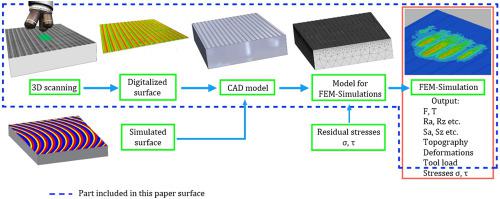Precision Engineering ( IF 3.5 ) Pub Date : 2020-12-10 , DOI: 10.1016/j.precisioneng.2020.12.004 Dmytro Borysenko , Florian Welzel , Bernhard Karpuschewski , János Kundrák , Vadym Voropai

|
Burnishing is a finishing manufacturing process that provides the required surface integrity of metal parts. Precise process simulation enables optimization to guarantee the quality of the product. A literature review showed that most researches in this field have used an idealized smooth surface for simulations and have not considered the influence of surface roughness on the simulation results. However, for burnishing processes, the initial roughness has a measurable effect on the simulation quality. Hence, an innovative approach for the preparation of the FEM process model was developed. The approach based on reverse engineering. Using 3D scanning, models of the workpiece and the tool were created and imported in the process model. The developed approach was validated through a case study. The results of the simulation with surface roughness demonstrate a better compatibility to the real process than the results of the same simulation on the idealized surface. Hence, using this approach, it is possible to create a precise model of the process and achieve more qualitative result of the burnishing simulations.
中文翻译:

真实表面结构上抛光过程的模拟
抛光是一种精加工制造过程,可提供所需的金属零件表面完整性。精确的过程仿真使优化成为可能,以保证产品的质量。文献综述表明,该领域的大多数研究都使用理想化的光滑表面进行仿真,而没有考虑表面粗糙度对仿真结果的影响。但是,对于抛光过程,初始粗糙度对模拟质量有可测量的影响。因此,开发了一种用于准备FEM过程模型的创新方法。该方法基于逆向工程。使用3D扫描,可以创建工件和工具的模型,并将其导入过程模型中。通过案例研究验证了开发的方法。与在理想化表面上进行相同模拟的结果相比,具有表面粗糙度的模拟的结果表明与真实过程的兼容性更好。因此,使用这种方法,可以创建一个精确的过程模型,并获得更清晰的模拟结果。











































 京公网安备 11010802027423号
京公网安备 11010802027423号